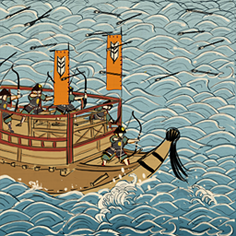
Basic Unit Statistics (can be modified by difficulty level, arts, skills, traits and retainers)
| Recruitment Cost | 100 | |
| Upkeep Cost | 50 | |
| Marines | 40 | 33% |
| Seamen | 5 | 2% |
| Hull Strength | 100 | 1% |
| Morale | 12 | 24% |
Strengths & Weaknesses
- Fast moving.
- Small crew who are mostly missile troops.
- Vulnerable if boarded.
- Crew very exposed to missiles.
Abilities
- Battle Speed - This increases a ship's rowing speed for a short period of time.
- Flaming Arrows - This unit can fire flaming arrows for a short period of time. Flaming arrows have a greater damage effect and can set fire to flammable objects. Flaming arrows don't function in wet weather.
Requires
Description
A bow ship is small, fast and manned by archers who bombard enemy crews.
The ship's purpose is to stay on the edges of a fleet, quickly moving to key points to provide fire wherever necessary. Its speed means it can avoid being boarded by soldiers from heavier, more powerful ships while harassing them with arrows. The crew of this vessel is not expected to launch boarding attacks, only soften up a target for other friendly ships. They also have the ability to fire flaming arrows for a short period of time, which are much more devastating than standard arrows. Ironically, the archers are also vulnerable to missile fire as the upper deck of the ship has no protection. During the Sengoku Jidai, ships were mostly made from wood, occasionally augmented by thick bamboo or iron plates. This made them inflammable, and it was quite common to set fire to a vessel prior to boarding it. Archers would use fire arrows, or bombs would be thrown, all in the interests of making life as difficult as possible for the defenders. However, boarding actions were the most important tactic of war at sea, and everything else was subordinated to them. This was just as well, as incendiary weapons lacked the power of cannons, which were hardly common. Japanese naval warfare never went the same way as European naval tactics, with ships becoming gun platforms and fighting at a distance for the most part.